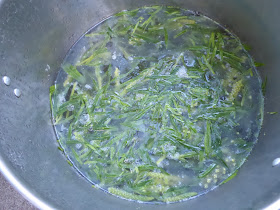As I paused to collect an armful of dock leaves, my companion, Elinor Gotland sighed.
"Why on earth bring home weeds when you've a whole garden full of dye plant flowers that need picking?"
"Well, I know pretty much what colours I'll get from my own plants and I fancied trying something new."
"You're such an adrenaline junky, Beaut. Couldn't you go bungee jumping instead of spoiling any more yarn?"
"This isn't just some random impulse, it's a cunning plan. Dock leaves could save me a lot of time and effort. In Jenny Dean's book 'Wild Colour', she says dock leaves fix yellow colours onto wool with no mordant." I snapped off one last spike and turned toward home. "Think about it, Elinor, dock is a plentiful wild dye plant so no time spent sowing, watering and tending to it and what's more, no time spent preparing fibres before dyeing them. Quick and easy."
"Yellow with no mordant? You're sure? All sounds that bit too good to be true."
"Well, I'm going to test these dock leaves out on some wool yarn. I'll try dyeing one unmordanted skein and one mordanted with 10% alum, see if there's any difference."
I simmered 400g of dock leaves in 10 litres of water and left them to cool overnight. When the leaves were sieved out next day, the dye (central sample) looked a very decent yellow. Testing with pH indicator strips showed it had become naturally acidic, adding vinegar to make the sample on the left more acidic made little apparent difference, while adding soda ash to make the sample on the right alkaline deepened the colour to a strong bronze.
"Feast your mistrustful eyes on that, Ms Gotland. Looks like a pretty good dye bath to me."
My companion glanced up from the crossword.
"Handsome is as handsome does, Beaut."
Two 100g skeins of wool went into the 400g dock leaf dye bath and were simmered for an hour and left overnight. Neither came out yellow. The one that had previously been mordanted with alum looked just a little browner, but if Elinor caught sight of this undeniably beige yarn, I was going to have to eat crow.
I put both skeins in an alkali rinse, hoping it would bring up the colour and it did shift them to a more golden beige. When one was further modified by heating it in an iron solution it turned a dark khaki green.
My companion wandered over.
"That's a lot of fuss you're going to with that quick and easy dock leaf dye, Beaut."
"Oh" I said airily "I've dyed loads of this yarn with yellow dye plants already. What I really needed was a bit of contrast colour."
One granny square pattern in heavy wool yarn on a 6mm hook was a quick and easy way to make a substantial footrest. The inside is stuffed with a considerable weight of failed experiments on yarn and fabric.
I name this pouffe 'Crouching Crochet, Hidden Beige'.

























































